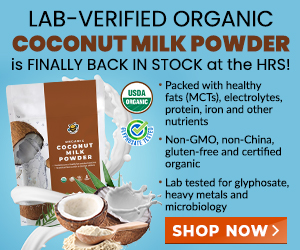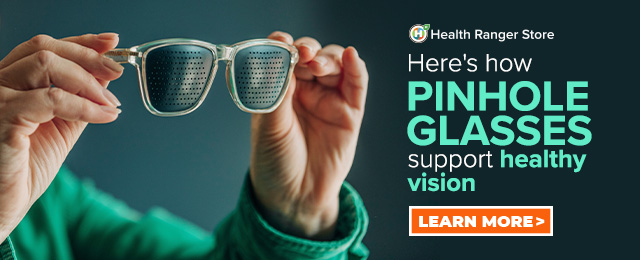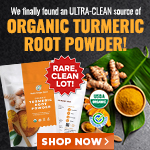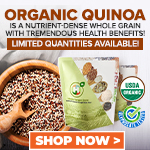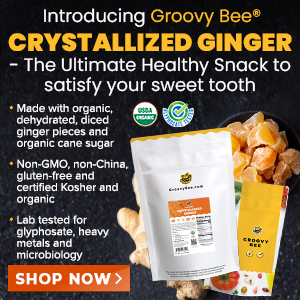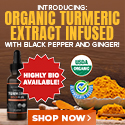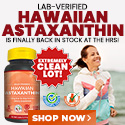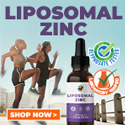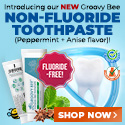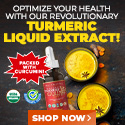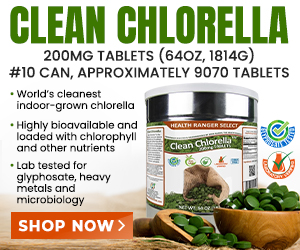
The Flavonoid Quercetin Protects Against Macular Degeneration
Friday, May 23, 2008 by: John Cole
Tags: quercetin, health news, Natural News
- Chemtrails unveiled: How the CIA and Big Business are manipulating the weather for profit
- Mysterious underwater pyramid off Japan could rewrite ancient history
- Israeli lobbyists boast of controlling US national security policy in leaked AIPAC audio
- How to live without electricity: A practical guide for survival and preparedness
- Geoengineers forced into secrecy as public backlash grows: How climate elites are manipulating populations to accept geoengineering experiments
- Tulsi Gabbard leads charge against the Biden regime’s global censorship of the 'Disinformation Dozen'
- Fauci is back in the limelight, and he’s busy promoting a future COVID or FLU pandemic
- Common household chemicals linked to America's depression epidemic
- Pfizer's RSV vaccine linked to preterm births as drug giant CONCEALED RISKS from pregnant women in unethical clinical trials
- Shedding light on the dark side of MMR vaccines: How vaccinated individuals SPREAD MEASLES & put the vulnerable at risk
- Analysis: The coming economic collapse, a mass uprising and Trump's three secret weapons to halt the growing revolt
- The HEART-HEALING power of SEVEN Mediterranean plants
- Over 30 pieces of evidence on how ‘the climate scam is collapsing’
- Aerosolized bioweapons? Strange “diploid biomasses” falling out of the sky in Florida captured under the microscope
- Widespread social and economic unrest: Steve Quayle issues urgent financial warning of imminent asset collapse in new interview with Mike Adams
- Tulsi Gabbard takes aim at censorship: Justice for the ‘Disinformation Dozen’
- Mike Adams releases country western hit single: Goin’ Back in Time is Comin’ Home
- U.S. lawmakers investigate Meta over alleged China collaboration
- Aerosolized bioweapons? Strange “diploid biomasses” falling out of the sky in Florida captured under the microscope
- Widespread social and economic unrest: Steve Quayle issues urgent financial warning of imminent asset collapse in new interview with Mike Adams
- CLOT SHOT PLANDEMIC UNFOLDING: Fibrous, rubbery clots caused by covid injections have prion-like seeding activity
- Analysis: The coming economic collapse, a mass uprising and Trump's three secret weapons to halt the growing revolt
- Kiss Your Genetic Privacy Good-Bye! 23andMe Gets Green Light to Sell Your Intimate Genetic Details to Anyone They Want
- Tulsi Gabbard leads charge against the Biden regime’s global censorship of the 'Disinformation Dozen'
- Mike Adams releases country western hit single: Goin’ Back in Time is Comin’ Home
- DEATH by VACCINE or face PRISON time: Canadian Freedom Convoy leaders CONVICTED for protesting forced vaccination during the Covid Plandemic
- Fauci is back in the limelight, and he’s busy promoting a future COVID or FLU pandemic
- How Israeli military-connected corporations are secretly controlling your online privacy
- European Court of Justice: Healthcare professionals who promoted or administered COVID-19 vaccines are CRIMINALLY LIABLE for any harm caused
- Defunding DEADLY mRNA jabs: Government funding for mRNA technology being scrutinized and sidelined until proven "safe and effective" for real
- Tulsi Gabbard takes aim at censorship: Justice for the ‘Disinformation Dozen’
- Federal employees whine over DOGE's new directive requiring them to do a 5-point summary of weekly accomplishments
- U.S. approves new Russian ambassador as diplomatic thaw continues
- I Want My Bailout Money – new song and music video released by Mike Adams
- Trump administration poised to overhaul crypto regulations with new SEC leadership
- I Want My Bailout Money – new song released by Mike Adams
- Newly released JFK files reveal Pentagon's role in creating Lyme disease and covid in the same lab
- Mike Adams releases country western hit single: Goin’ Back in Time is Comin’ Home
- Analysis: The coming economic collapse, a mass uprising and Trump's three secret weapons to halt the growing revolt
- MEDICAL BOMBSHELL: FDA admits Covid mRNA 'Vaccines' CAUSE CANCER
- Dr. Mike Yeadon releases 15-minute testimony - WATCH - about genocidal intent of COVID “vaccines”
- Trump reverses course on Gaza plan, says “nobody is expelling Palestinians”
- 5 Simple steps to boost your brainpower: How to strengthen executive function in a distracted world
- The Health Ranger releases “Vaccine Zombie” song and music video, using AI-animated zombies for the music video
- California's social media censorship law struck down: A victory for free speech or a threat to online safety?
- Rep. Nancy Mace introduces bill to ban biological males from female facilities on federal property
- EPA advisor admits the agency is funneling billions to climate groups ahead of Trump’s return to White House
- Survival 101: Effective EMF blocking techniques
- Aerosolized bioweapons? Strange “diploid biomasses” falling out of the sky in Florida captured under the microscope
- OpenAI whistleblower who dissented against how the company trained ChatGPT found dead
- Trump Administration cuts 2,000 USAID jobs, places most employees on leave in sweeping reform effort
- A lack of integrity in Academia: Harvard professor found GUILTY of fraudulent research to promote CRT theory
- Sugarcane extract superior to cholesterol-lowering drugs?
- RFK Jr.'s SSRI antidepressant investigation sparks liberal meltdown, exposes Big Pharma's dangerous game
- Red Cross issues warning to stop blood plasma donations from vaccinated people
- Scientists confirm: GENIUS brain function can be spontaneously unleashed in humans without any apparent cause
- EPA advisor admits the agency is funneling billions to climate groups ahead of Trump’s return to White House
- HYSSOP: What research reveals about the health benefits of this ancient holy herb
- Two containers with completed ballots fall out of truck in Florida
- Fully vaccinated about to see “tsunami” of illness and death, warns virologist
- Global leaders unite to clamp down on “misinformation” with UN-backed Cascais Declaration
- Newly released JFK files reveal Pentagon's role in creating Lyme disease and covid in the same lab
- BREAKING: 2025 NDAA authorizes mandatory military draft of WOMEN across America… as Pentagon pursues global NUCLEAR war with both Russia and China at the same time
- Michael Yon warns of a ZIONIST TAKEOVER in Trump’s second administration
- Ozempic and Wegovy weight loss drugs are injectable LIZARD VENOM PEPTIDES that may unleash a devastating wave of organ failure… side effects align with symptoms of SNAKE BITES
- The Health Ranger releases “Vaccine Zombie” song and music video, using AI-animated zombies for the music video
- BOMBSHELL: DNA testing kits are a SCAM to develop ethnic-specific bioweapons
- Israeli soldiers accused of even more torture and abuse in the West Bank
- These 13 countries just signed an agreement to engineer a global FAMINE by destroying food supply
- Mike Adams releases country western hit single: Goin’ Back in Time is Comin’ Home
- NASA admits that climate change occurs because of changes in Earth’s solar orbit, and NOT because of SUVs and fossil fuels
- RFK Jr. clears key hurdle: Sen. Susan Collins backs controversial HHS nominee, signaling a new era for health policy
There are two types of ARMD: dry and wet. The dry type is much more common than the wet type and accounts for up to 90% of ARMD. In the dry type, the macula gradually thins with aging. The pigmented retinal epithelium, which is the dark-colored cell layer at the back of the eye essential for vision, is gradually lost. One of the first signs of ARMD is loss of color sensitivity and blurring or haziness while reading.
Previous reports have concluded that eating foods rich in lutein and zeaxanthin can help protect the macula, that obese individuals have lower amounts of macular pigment than non-obese people, and that people with very low body fat levels have a higher amount of carotenoids in their blood, which could lead to more pigment in the macula.
The Background of the Recent Report
The current research report states that oxidative stress plays a central role in macular damage, and that some previous studies have shown that intake of foods with a high level of antioxidants may lead to a lower risk of ARMD; "recommended supplementary antioxidants include vitamin C, vitamin E, beta carotene, and lutein".
Another group of antioxidants that may be protective are the bioflavonoids: "the large group of polyphenolic compounds that provide much of the color and flavor of plant foods". The most-studied bioflavonoid is quercetin, which is well known to be present in apples and onions, and has already been shown to have anti-allergic, anti-inflammatory, anti-carcinogenic, anti-viral, and anti-thrombotic properties. It is a strong antioxidant and free-radical scavenger.
The Experiments
The study used cultured human cells of the retinal pigmented epithelium treated with hydrogen peroxide as the oxidative stress agent. Oxidative damage was measured using a special histochemical staining procedure.
Cells treated with hydrogen peroxide alone (the control group) suffered significantly more damage than cells treated with hydrogen peroxide and quercetin. Intracellular glutathione (one of the body's intrinsic antioxidants) was not altered by hydrogen peroxide treatment or by quercetin (glutathione was measure as reduced GSH only in this study), showing that quercetin's protective effects might be independent of glutathione. (However, previous studies, which measured different forms and ratios of glutathione, have shown increased intracellular glutathione after addition of quercetin.)
The protective mechanisms of quercetin were demonstrated to be related to its ability to reduce the activity of caspase-3 and level of caveolin-1, both of which were induced by hydrogen peroxide.
Not too low, Not too high
Healthful circulating levels of quercetin (0.1 to 1 micromole) can be achieved by consuming 100 to 200 grams of onion a day. Other foods containing ample quercetin are listed as capers, ancho peppers, cranberries, fennel, cocoa, black currants, buckwheat, black tea, spinach, and wild greens.
Very high concentrations, 100 micromoles or higher, have been suggested in laboratory studies to induce chromosomal damage or cytotoxicity. So, "like many other especially lipid-soluble antioxidants, excessively elevated serum levels of quercetin may cause cellular injury." (These very high levels were produced in laboratory experiments, but could also probably result from taking too many supplements.)
Conclusion
Although this was an in vitro (test-tube) study, based on the present study's results and past findings, the authors conclude, "quercetin appears to be a candidate as food supplement in the prevention of early pathologic changes" in ARMD.
Journal, Research Facility
The study, reported in Investigative Ophthalmology & Visual Science, was carried out at the Department of Ophthalmology, Ludwig-Maximilians-Universitat, Munich, Germany.
Background Information
1. macula: (http://www.answers.com/macula?cat=health&y=0...)
2. macular degeneration (LEF):
(http://search.lef.org/cgi-src-bin/MsmGo.exe?...)
3. macular degeneration (AnswersDotCom):
(http://www.answers.com/macular+degeneration?...)
4. mole (micromole): (http://www.answers.com/mole?cat=technology&y...)
About the author
John H. Cole has been editing medical manuscripts for publication in mainstream U.S. and European medical journals for the past 15 years in Japan. He also has a small English school in Gifu City, Japan. He believes that natural foods, superfoods, herbs, exercise, sunshine, good sleep, and avoidance of pollution are the answers to most people's health problems. He is a friend of nature.Quercetin at FETCH.news
Get independent news alerts on natural cures, food lab tests, cannabis medicine, science, robotics, drones, privacy and more.
Take Action: Support Natural News by linking to this article from your website
Permalink to this article:
Embed article link: (copy HTML code below):
Reprinting this article:
Non-commercial use OK, cite NaturalNews.com with clickable link.
Follow Natural News on Facebook, Twitter, Google Plus, and Pinterest
Science News & Studies
Medicine News and Information
Food News & Studies
Health News & Studies
Herbs News & Information
Pollution News & Studies
Cancer News & Studies
Climate News & Studies
Survival News & Information
Gear News & Information
News covering technology, stocks, hackers, and more



"Big Tech and mainstream media are constantly trying to silence the independent voices that dare to bring you the truth about toxic food ingredients, dangerous medications and the failed, fraudulent science of the profit-driven medical establishment.
Email is one of the best ways to make sure you stay informed, without the censorship of the tech giants (Google, Apple, Facebook, Twitter, YouTube, etc.). Stay informed and you'll even likely learn information that may help save your own life."
–The Health Ranger, Mike Adams










